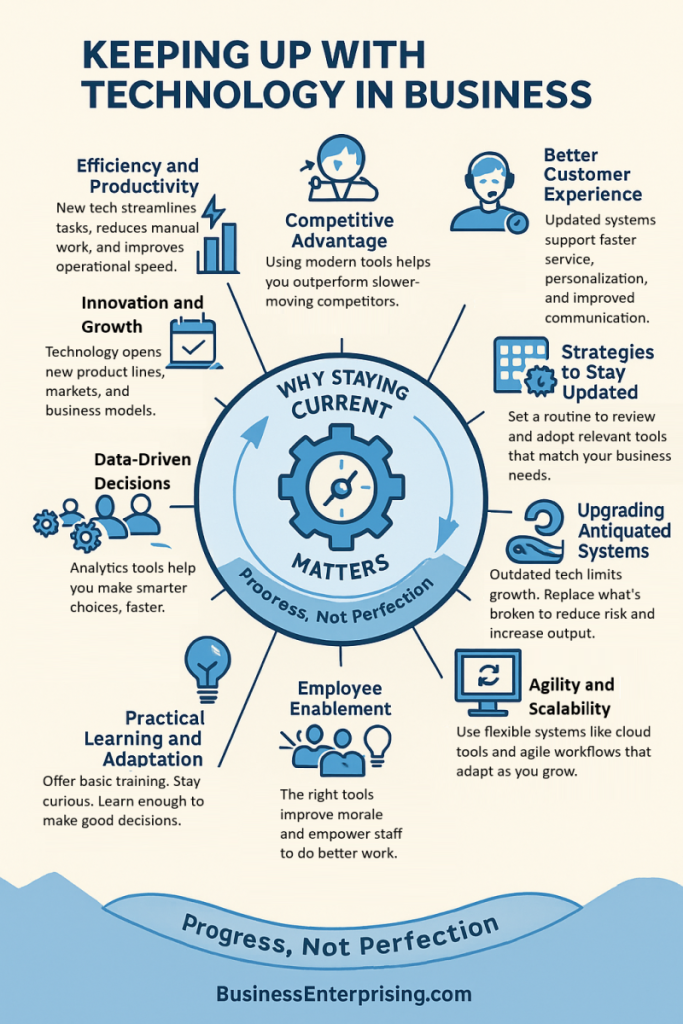
Additionally, your customers expect fast and seamless interactions. If your systems are outdated, your service may feel slow or limited. However, new tools often improve both customer experience and internal operations. Better systems help your team respond faster and make fewer mistakes.
Technology also affects how your team works together. Collaboration tools, automation, and cloud systems reduce time spent on repetitive tasks. Therefore, staying current allows you to focus more on strategy and less on fixing problems. Your team spends more time adding value.
However, not all updates make sense for your business. You need to choose tools that fit your needs, goals, and workflow. Focus on what improves results, not what sounds impressive. Additionally, talk to your team to find out what slows them down.
Regular updates also protect your business from larger issues. Outdated software can increase your exposure to bugs, crashes, or security risks. Therefore, updating your tools is both a performance and protection decision.
Technology will continue to evolve. Your job is to keep pace without overcomplicating your operations. With steady attention and smart choices, your business can grow alongside the tools that support it.
The Importance of Staying Up-to-Date with Technology
Technology moves quickly, and your business needs to move with it. Tools that worked well last year may slow you down now. Therefore, keeping up with technology is part of staying competitive. If you fall behind, your costs rise and your results suffer.
Additionally, your customers expect convenience, speed, and smart service. Outdated systems can make your business look unprofessional or unreliable. However, the right tools improve how you serve and connect with them. From communication to automation, each upgrade brings real value.
You do not need to chase every trend. Instead, focus on tech that solves a problem or makes something faster. Therefore, assess your current systems regularly. Look at where tasks take too long or results fall short. Technology can often fix those gaps.
Additionally, updated tools help your team work better. Collaboration becomes easier. Mistakes go down. Output goes up. These are small shifts that add up over time. They also show your team that you invest in their success.
However, technology also changes your competitors. If they use better systems, they can deliver faster or charge less. That puts pressure on your margins and market share. Therefore, staying current helps protect what you’ve built.
Every business grows through change. If you adopt smart tools and drop what no longer works, you gain an edge. Keep your focus on what makes work smoother, faster, or more reliable. That’s how you stay relevant in a fast-moving market.
Enhanced Efficiency and Productivity:
The first thing to remember is that adopting the latest technologies can streamline operations, automate repetitive tasks, and improve overall efficiency. Accordingly, this leads to increased productivity and cost savings.
Competitive Advantage:
Staying ahead of technological trends also helps businesses gain a competitive edge. In fact, companies that leverage new technologies can differentiate themselves from competitors and offer superior products or services.
Improved Customer Experience:
Additionally, modern technology enables businesses to provide better customer service, personalized experiences, and faster response times. Satisfied customers are more likely to remain loyal and recommend the business to others.
Innovation and Growth:
After all, technology has been known to drive innovation by opening up new opportunities for product development, market expansion, and business models. Staying current allows businesses to capitalize on these opportunities and foster growth.
Data-Driven Decision Making:
Advanced data analytics and business intelligence tools help companies make informed decisions. Access to real-time data and insights enables businesses to respond swiftly to market changes and customer needs.
Strategies for Staying Updated
Staying current with technology requires more than checking updates now and then. You need a steady process for gathering useful information. Therefore, you should make it part of your regular routine. That helps you avoid falling behind without overloading your schedule.
Start with trusted sources. Subscribe to tech newsletters related to your field. Additionally, follow relevant forums or blogs. These give you updates without requiring too much time. However, be selective. Focus on content that speaks to your actual business needs.
Your network can also be a source of insight. Talk to peers about the tools they use and what works for them. Therefore, make time for conversations at industry events or through online groups. Listening to others often reveals solutions you haven’t considered.
Additionally, set aside time each quarter to review your tech setup. Look at what’s outdated, what’s working, and what can improve. However, avoid chasing trends that don’t offer clear value. Focus on upgrades that support efficiency or solve specific issues.
Workshops and short training sessions also help. You don’t need deep technical knowledge. You need enough to make smart choices. Therefore, encourage your team to stay informed too. Shared knowledge leads to better decisions and stronger execution.
Keeping up with technology is not about knowing everything. It’s about staying aware of what might help or hurt your progress. If you stay curious, filter wisely, and keep your goals clear, you’ll stay ahead without losing focus.
Stay Informed About Industry Trends:
Regularly follow industry news, blogs, and publications to stay updated on technological advancements. Subscribe to newsletters, join professional networks, and attend industry conferences and webinars to gain insights into emerging trends and innovations.
Invest in Continuous Learning and Development:
Encourage and support continuous learning among employees. Offer training programs, workshops, and certifications to help staff stay current with the latest technologies. Create a culture of lifelong learning that values and promotes skill development.
Leverage Technology Consultants and Experts:
Work with technology consultants and experts to identify relevant technologies for your business. Consultants can provide valuable insights, help assess technological needs, and recommend suitable solutions.
Adopt a Flexible IT Infrastructure:
Implement a flexible IT infrastructure that can adapt to technological changes. Cloud-based solutions and modular systems allow businesses to scale and integrate new technologies seamlessly.
Foster a Culture of Innovation:
Encourage employees to explore new ideas and experiment with emerging technologies. Create an environment where innovation is rewarded and failure is seen as a learning opportunity. Set aside resources for research and development to drive innovation.
Upgrading Antiquated Systems
Old systems may feel familiar, but they often slow you down. Over time, they limit your ability to compete or grow. Therefore, upgrading antiquated tools becomes necessary. If your team wastes time on clunky software or hardware, it affects your bottom line.
Additionally, newer systems often come with better support, automation, and integration. These improvements help you work smarter, not harder. However, upgrades should match your business needs. Don’t replace everything at once. Start with the systems causing the most friction.
Talk to your team before making changes. They know where things break down. Therefore, use their feedback to guide priorities. A well-planned upgrade reduces disruption and builds trust during the process. Additionally, train staff early so they feel confident with the new tools.
Costs often hold people back from updating. However, older systems often bring hidden expenses. They create delays, errors, and workarounds that drain resources over time. Investing in better tools now prevents bigger losses later.
Keeping up with technology includes retiring what no longer works. New tools can speed up tasks, reduce errors, and improve customer service. Therefore, view upgrades as part of your long-term plan, not as a one-time fix.
Every system has a lifespan. Once it stops adding value, it starts adding risk. By staying proactive, you protect your efficiency and reputation. Better systems help your team do better work. That kind of upgrade pays for itself.
Implement Agile Methodologies:
Agile methodologies enable businesses to respond quickly to technological changes. Adopting agile practices, such as Scrum or Kanban, can enhance project management, improve collaboration, and accelerate the adoption of new technologies.
Collaborate with Technology Partners:
Partner with technology vendors, startups, and research institutions to stay ahead of technological advancements. Collaboration can provide access to cutting-edge technologies, shared expertise, and co-development opportunities.
Utilize Technology Roadmaps:
Develop and maintain a technology roadmap that outlines your strategic goals and the technologies needed to achieve them. A roadmap helps prioritize technology investments and ensures alignment with business objectives.
Invest in Automation and Artificial Intelligence:
Explore opportunities to automate repetitive tasks and processes using robotics, artificial intelligence (AI), and machine learning. Automation can enhance efficiency, reduce errors, and free up employees for more strategic work.
Monitor Competitor and Industry Practices:
Keep an eye on competitors and industry leaders to understand how they are leveraging technology. Benchmarking against industry best practices can provide insights and inspiration for your technology strategy.
Conclusion
Keeping up with technology helps you stay competitive, save time, and improve how your business operates. Each step forward adds value. However, staying current is not a one-time project. It’s an ongoing part of running a responsive, efficient business.
Additionally, the right tools improve your workflow without adding confusion. You don’t need to follow every trend. You need to focus on what fits your goals. Therefore, take time to review what works and what needs to be replaced. Thoughtful updates reduce wasted time and improve your results.
Your team also benefits when tools make their work easier. Fewer delays, better accuracy, and faster communication support both morale and performance. Therefore, involve your team in the process. Their input can guide better decisions and improve adoption.
Outdated systems come with hidden costs. However, smart upgrades often pay for themselves over time. You gain back lost time, reduce errors, and improve customer satisfaction. These benefits help your business grow with fewer obstacles.
Technology will keep changing. Your response should be steady and practical. Evaluate often, ask questions, and act with purpose. That approach helps you stay flexible without losing focus.
If you build habits around reviewing and improving systems, your business stays ready for what’s next. Keeping up with technology is about progress, not perfection. Make changes that support your goals, and let the rest follow.


